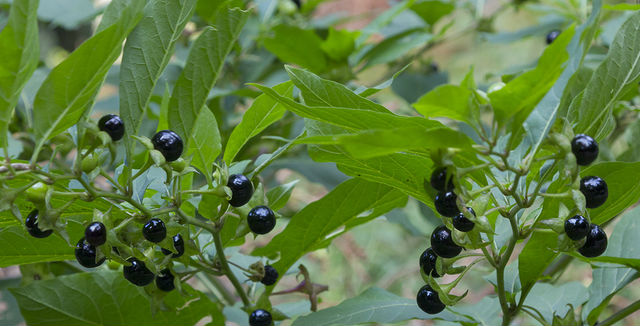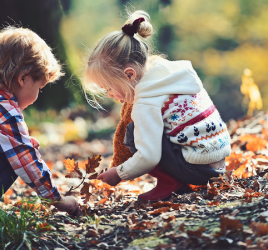7 Fatal Plants You Need to Avoid

Deadly nightshade bush with toxic berries
As a child, I remember my mother pointing out certain berries that were found all over our yard. She made sure to warn us not to eat those berries. While the berries from the bushes looked delicious with their bright red color, and they seemed as juicy as a raspberry, they were actually very toxic and could make us very sick if we ate them. Thankfully my mother knew better.
Throughout history, people had to learn through trial and error which plants were good to eat and which ones to avoid.
While most plants are typically a great source of nutrition, many are poisonous. In fact, there are hundreds of plants that are toxic for humans to ingest. You might be surprised that you could be growing them right in your own backyard.
Throughout history, plants have been the ones to blame for many deaths. While many of the plants might look harmless, many plants can contain some of the deadliest poisons known to man. It is important to be careful when attempting to eat an unknown plant. Some plants can lead you down a deadly path you really want to avoid.
The World’s Most Fatal Plants
Here are 7 of the world’s most fatal plants.
- Water Hemlock
This plant is closely related to the poison hemlock that famously killed Socrates. The Water hemlock has been known to be the most violently toxic plant in North America. It is a large wildflower that resembles Queen Anne’s Lace and can be confused with edible parsnips or celery.What sets the water hemlock aside is the deadly cicutoxin that is contains, especially inside its roots. When this plant is eaten, it can create potentially fatal symptoms. One can expect to experience painful convulsions, abdominal cramps, nausea, and death. If one is lucky enough to survive an episode with the water hemlock, they can expect to experience amnesia or lasting tremors.
- Deadly Nightshade
The deadly nightshades have dull green leaves and shiny black berries about the size of cherries. The danger lies in just about every part of plant.The deadly nightshade contains atropine and scopolamine in its stems, leaves, berries and roots. When consuming these parts, it can cause paralysis in the muscles of the body, including the heart. Just touching the plant can cause skin irritation. The sweet fruit can lure unsuspecting children and adults. According the legend, Macbeth’s soldiers poisoned the invading Danes with wine made from the sweet, yet deadly fruit.
- White Snakeroot
The white snakeroot is a North American herb that has a flat-topped with clusters of small white flowers. The small white flowers contain a toxic alcohol known as termatol.Sadly, this plant is famous for causing Abraham Lincoln’s mother to die. While many can simply die by eating the plant, for Nancy Hanks, she was poisoned by drinking the milk from a cow who had grazed on the plant. The meat and the milk from poisoned livestock and be passed on to any human that consumes it.
According to Briannica.com, for those that have been, “milk poisoned” the symptoms include loss of appetite, nausea, weakness, abdominal discomfort, reddened tongue, abnormal acidity in the blood, and death.
Don’t worry. Farmers are well aware of the life-threating hazards of this plant and make sure to keep it far away from their animal pastures.
- Castor Bean
The castor bean plant is native to Africa. When their seeds are processed, they will create castor oil and they naturally contain the poison ricin. This poison is deadly even in small amounts.Most of the fatalities from the castor bean plant are caused by accidental ingestion by pets and children. The castor oil plants can be found in houses and gardens all over the world. The seeds are so dangerous that they are currently the holder of the Guinness Book of World Records as the title of the world’s most poisonous plant.
The poison has been used to attempt to kill U.S. politicians by continuing it inside their mail. It was used to assassinate Geiorgi Markov, a journalist who spoke out against the Bulgarian government. According to Britannic.com, ricin works by inhibiting the synthesis of proteins within cells and can cause extreme vomiting, diarrhea, seizures, and death. A child can be killed from just one to two seeds.
- Tobacco
It can be argued that tobacco is the deadliest plant on the planet and is the most widely grown commercial non-food plant in the world. Every part of the plant including the leaves contain the toxic alkaloids nicotine and anabasine, and both can be fatal if ingested.In spite of the poisonous features, the nicotine from tobacco is consumed by many people all over the world. Nicotine is both psychoactive and addictive. Tobacco is known to cause more than 5 million deaths per year.
- The Manchieel Tree
The nickname for the manchieel tree is called, “The little apple of death”, and there is very good reason. Simply brushing up against the nanchineel tree can give your skin a violent allergic reaction.Imagine standing underneath this tree in a rain storm. The runoff alone will leave your skin blistered. Found in the trees milky sap are many different poisons. One poison specifically is phorbol which contributes to the epidermal effects.
The tree will produce an apple looking fruit. When this fruit is eaten, it is often fatal because of the physostignmine content. In addition, it can lead to nausea, vomiting, diarrhea, and seizures. In the end, if you ever come across the manchineel tree, just run the other way.
- Rosary Pea
The rosary pea plant got its name as it was used as an ornamental bead for rosaries. However, these beads are extremely dangerous and deadly when they are broken. Many jewelry makers have died after getting their finger pricked from handing the rosary pea. Abrin, closely related to the poison ricin found in the castor bean, is the poison to blame for its lethal ability.
Wrapping Up
In conclusion, these seven different plants are definitely dangerous with their poisonous and fatal consequences. If you ever come across these plants, make sure you stay clear away.

